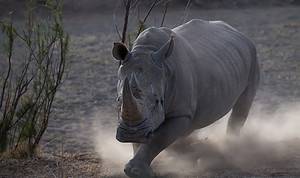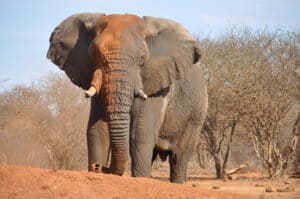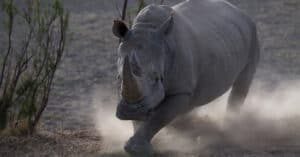Rhinos are the second-largest land animal next to the elephant and once lived all over Africa and parts of India and Southeast Asia, but rhinos are currently facing a critical threat of extinction due to persistent poaching and habitat loss.
According to recent estimates, there are only around 27,000 rhinos left in the wild, with very few surviving outside of protected national parks and reserves. Three species of rhino, including the black, Javan, and Sumatran rhinos, are classified as critically endangered by the International Union for Conservation of Nature’s Red List of Threatened Species. Despite conservation efforts, their numbers continue to decline, highlighting the urgent need for action to protect these magnificent creatures.
In the last 25 years, three subspecies have become extinct. There are only two northern white rhinos left in the world today (2022) and they are both females. The last remaining male passed away in 2018 leaving the two females to be cared for at the Ol Pejeta Conservancy in Kenya. More about them later, but first let’s look at all of the rhino species.
How many Rhino Species are There?
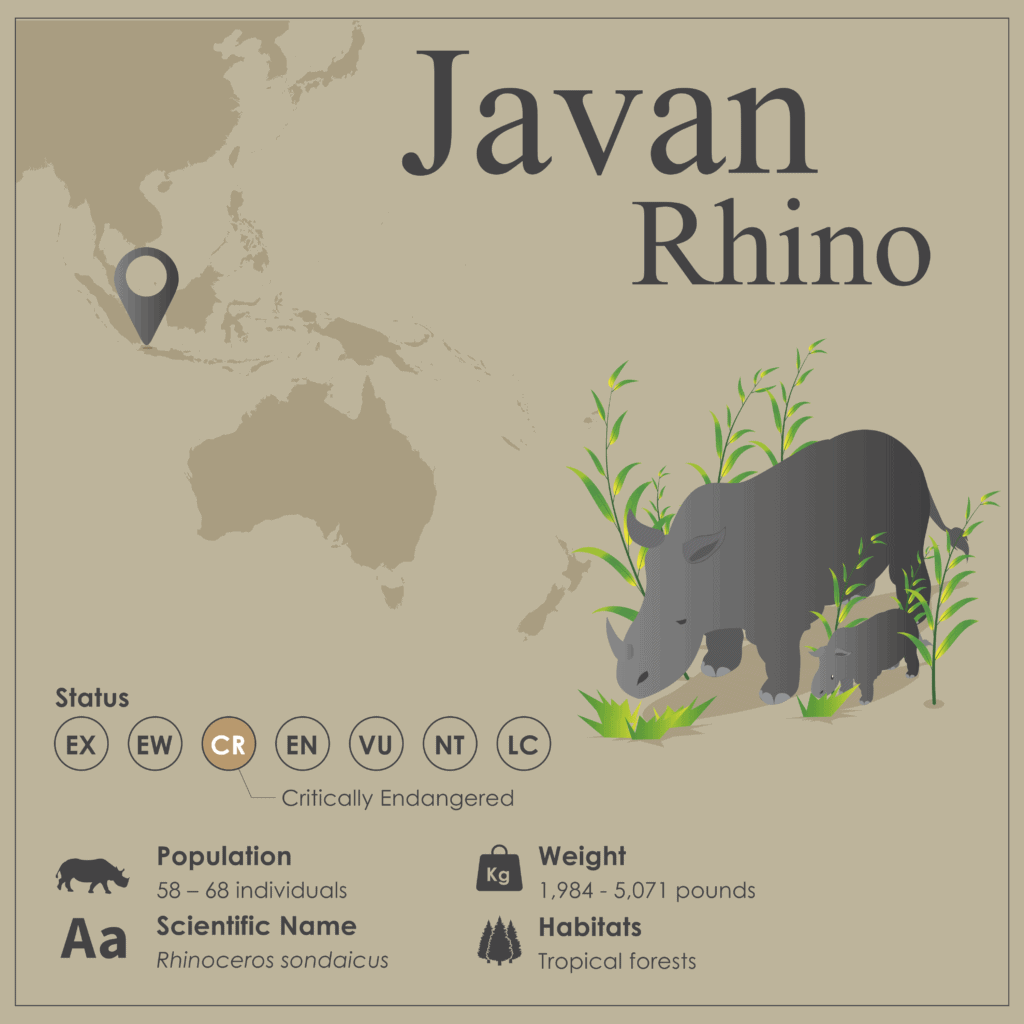
The Javan
Rhinoceros
is one of the most endangered large mammals in the world
©Takaip/Shutterstock.com
There are five rhino species left in the world today. Most species have subspecies, which live in different areas and have small differences in appearances (morphology). There are two rhino species from Africa and three of the species from Asia. Following is a list of the rhino species:
- White Rhinos
- Northern White
- Southern White
2. Black Rhinos
- Eastern Black
- Western Black
- South-Eastern Black
3. Greater One-Horned (Indian) Rhinos
4. Sumatran Rhino
5. Javan Rhino
- Indian Javan Rhino
- Vietnamese Javan
- Javan Rhino
How many Rhinos are left in 2022?
Collecting data on the number of animals in the wild can be difficult, so the following numbers are based on two sources; first the International Union for Conservation of Nature records the numbers for all animal species and secondly the International Rhino Foundation maintains current research on all the rhino species. Data from both of these groups will be provided to gauge the range of remaining rhinos of each species.
White Rhinos -Remaining Population of 10,082-18,002
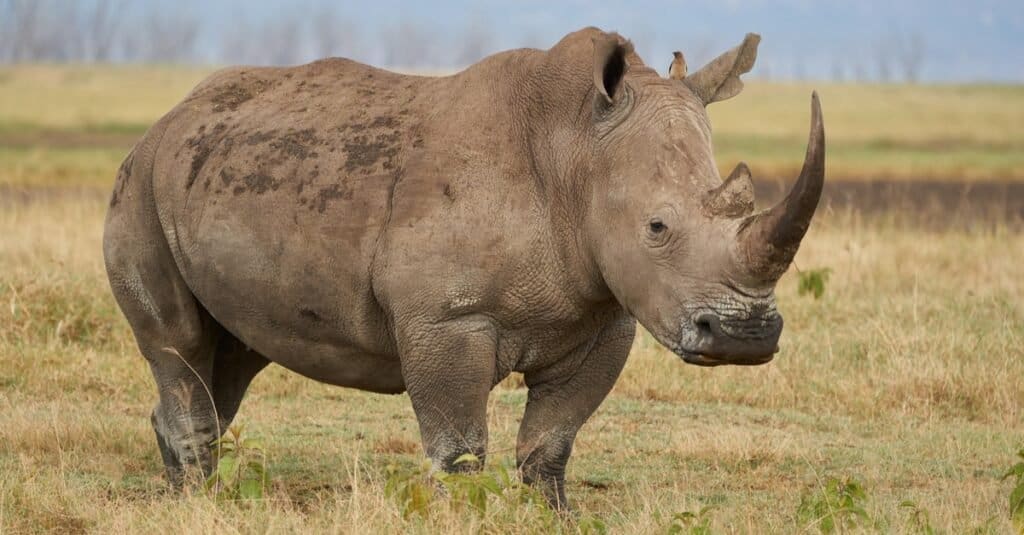
White rhino populations have rebounded have historic lows. Unfortunately, the northern white rhino is now functionally extinct as no males survive.
©Rocchas/Shutterstock.com
White Rhinos have two subspecies, Northern white and Southern white. The Northern white has the fewest living animals of all the species and the Southern white has the most of all the rhinos.
- Southern white rhinos 10,080-18,000: Southern white rhinos live in Southern Africa on the savanna and grasslands. The IUCN lists the number at 10,080 and is decreasing in numbers despite conservation efforts. They are currently listed as “Near Threatened”. According to the International Rhino Foundation (IRF) the estimate is closer to 18,000 now. However, the number of southern white rhinos in Kruger National Park is significantly down. A report from South African National Parks reported the number of rhinos at Kruger National Park is down 67% from 2011-2019. The IRF said the numbers of poaching decreased in 2020 with the closure of the borders during lockdowns, but that there is now an increase in poaching again.
- Northern white rhinos 2: Yes, you read that right, there are only 2 remaining northern white rhinos and they are both females. The IUCN lists them as “Critically Endangered (Possibly Extinct in the Wild)”. They are being guarded at the Ol Pejeta Conservancy in Kenya. The last male passed away in 2018 so is there any hope for this subspecies? Scientists are working with what is called an “assisted breeding program” in which they are using in-vitro fertilization with the sperm from deceased Northern white rhinos. Scientist have created 12 embryos from the eggs of one of the remaining rhinos (her name is Fatu). They have recently stopped trying to retrieve eggs from the other remaining female (Najin) due to her health status and age. Both females are too old to carry a baby to term so they plan to use a surrogate rhino to carry the hopeful baby. They are currently working with the Kenya Wildlife Service to locate a suitable surrogate. Several other organizations are involved, trying to make the most ethical and considerate decisions to try to save these rhinos from extinction.
Black Rhinos – Remaining Population of 1,808-5,600
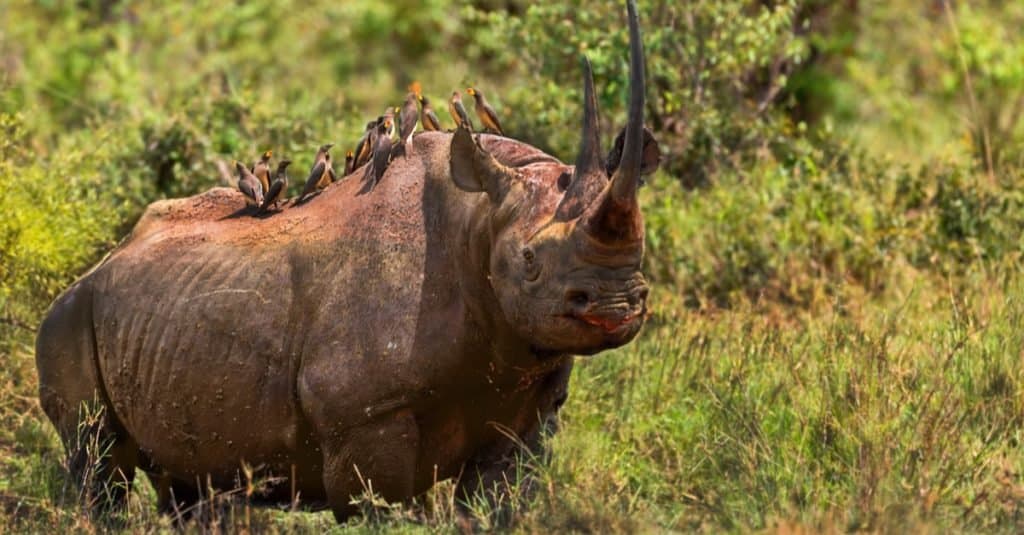
Black rhinos saw their populations crash during the second half of the 20th century.
©Maggy Meyer/Shutterstock.com
Black rhinos have three subspecies and live in Eastern and Southeastern Africa. (Side note that both white rhinos and black rhinos are actually not white or black and are both a similar grayish-brown.) Of the three subspecies, the Southeastern black rhino is the most populous.
- Southeastern black rhinos 1,225-5,600: The Southeastern black rhino live in parts of Nambia, Angola and Zambia and at 1,225 individuals, are listed as “Critically Endangered” by the IUCN. However, their numbers are increasing. According to the IRF the number of black rhinos has increased 16-17% in the last ten years. The largest population of black rhinos can now be found in Africa Etosha National Park where the Nambia government has instituted a highly successful program to protect their rhinos.
- Eastern-black rhinos 583: The IUCN lists these rhinos as “Critically Endangered” but increasing in numbers as well. The remaining rhinos in this area live in protected sanctuaries and in Kenya they were proud to report their first “zero poaching year”. That is promising news for the black rhinos!
- Western black rhinos, 0 (Extinct since 2006): Unfortunately, the Western black rhinos were not so fortunate. The last recorded western black rhino was in Cameroon. Researchers use several techniques to verify if a species is extinct, including reported sightings, evidence of dung and signs of feeding. Sadly, the IUCN declared this subspecies extinct in 2006.
Greater One-Horned (Indian) Rhinos – Remaining Population of 2,200-3,700
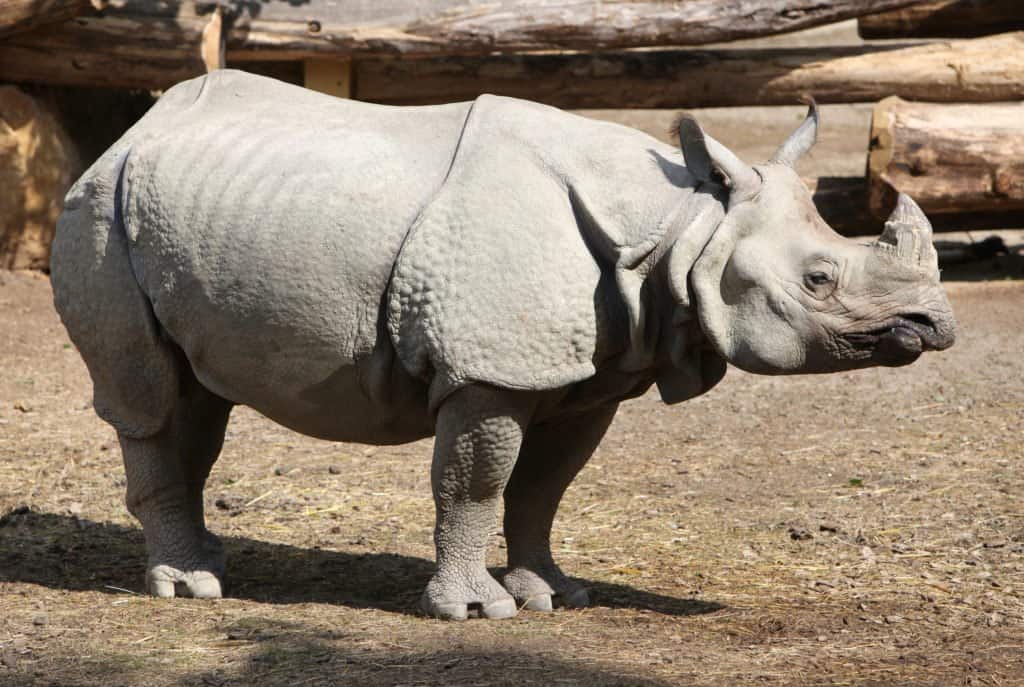
Indian rhinos have rebounded from the edge of extinction thanks to conservation efforts!
©Reinhold Leitner/Shutterstock.com
There are not any subspecies of the Greater one-horned rhino (sometimes referred to as the Indian rhino). These rhinos are an example of the success that can come from multiple organizations joining together to make a difference. There were once only 100 of these rhinos left! Now the IRF reports there are 3,700! Officials in India and Nepal have recorded multiple years with a decline in poaching which is clearly helping this species increase in numbers. The IUCN has them listed as “Vulnerable” but increasing in numbers with the last census being in 2018 with an estimate of 2,100-2,200. Greater one-horned rhinos only have one horn and are the 2nd largest of all of the rhino species.
Sumatran Rhinos – Remaining Population of 30-80
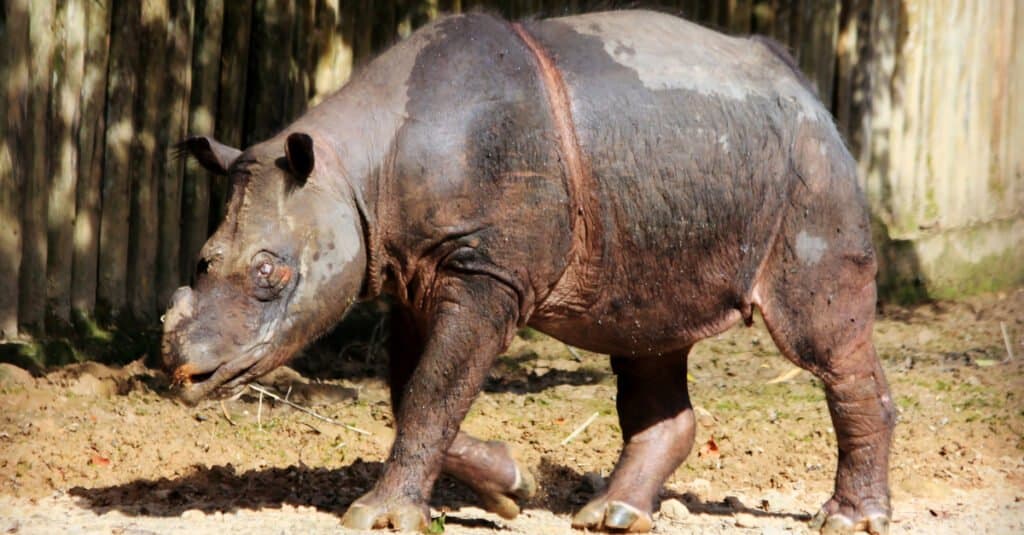
Though it’s still a large animal, the Sumatran Rhinoceros is the smallest — and one of the rarest — of all the Rhinocerotidae members.
©ylq/Shutterstock.com
Sumatra is one of the islands in Indonesia. The Sumatran rhino lives on this island as well as on the island of Borneo in the tropical forests. The last census in 2019 the IUCN listed the number as low as 30 remaining rhinos making them “Critically Endangered” and decreasing in number. According to the International Rhino Foundation, the biggest obstacle for this species is the loss of habitat leading to dwindling numbers making it difficult for them to locate mates. Since they live in dense tropical forests it is also harder to gain an accurate count. Their estimate is closer to 80 remaining rhinos. The Indonesian government is not giving up on this species and has enacted Indonesia’s Emergency Action Plan for Sumatran Rhinos.
Javan rhinos 18-75
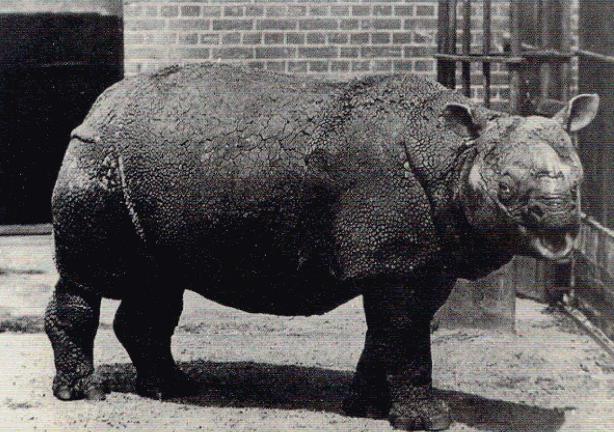
Javan Rhinos have long been on the edge of extinction, but survive in a single National Park.
©T.Dixon – Public Domain
The Javan rhinos are broken down into three subspecies, the Javan, Indian Javan, and Vietnamese Javan. Java is also one of the islands of Indonesia and is a tropical forest habitat.
- Javan rhinos 18-75: The Javan rhino population is now limited to one location, the Ujung Kulon National Park. This park is the home of many unique animals with 9 others being listed on the IUCN’s red list. In 2019 the IUCN listed the Javan rhinos as “Critically Endangered” with only 18 remaining. The Ujung Kulon Park website estimates closer to 60 are there and the International Rhino Foundation has updated the number to 75. The exciting news out of Java is “Indonesia’s Ministry of Environment and Forestry has announced four Javan rhino births in the first half of 2021”. Clearly something to celebrate!
- Indian Javan rhino 0 (Extinct since 1920): This subspecies of rhinos used to roam northern India, Bangladesh and Myanmar but has been extinct since about a hundred years ago. The IUCN lists them as Extinct.
- Vietnamese Javan rhino 0 (Extinct since 2010): This latest extinction is disturbing due to the fact that the last remaining Vietnamese Javan rhino was poached. In April of 2010 a female rhino that was 25-30 years old was found shot at the Cat Tien National Park in Vietnam. The park had reported a population of 10-15 rhinos, but over the years they were unable to protect them. These rhinos used to be in Vietnam, Lao PDR, Cambodia and Eastern Thailand.
What are Conservationists doing to help keep rhinos from going extinct?
There are many nonprofit agencies and governments that are working together to protect the rhino populations. Three programs that are helping prevent more rhino species from going extinct are Translocation Programs, Dehorning Programs, and Protected Sanctuaries.
The translocation programs physically move rhinos from risk areas to new locations where they can breed and start new populations. The World Wildlife Fund is working in South Africa with Ezemvelo KZN Wildlife and Eastern Cape Parks and Tourism. In the past 20 years, they have relocated 201 black rhinos to new locations and started 12 new populations.
Dehorning programs evaluate the pros and cons of this procedure and ultimately decide to have a trained vet remove the horns of some rhinos and release them back into the wild to safeguard them from being killed for their horns. At the Zululand Rhino Reserve in South Africa, they have decided to use dehorning programs in order to protect their white rhino population.
Several countries have formed Protected Sanctuaries for their rhinos. As mentioned above, the last remaining Javan rhinos are protected at the Ujung Kulon National Park. Scientists are able to study the rhinos in these small settings and also are able to have stricter controls over potential poachers.
Progress is being made in saving all of the remaining rhino species, but the realities of the demand for rhino horns can not be ignored. So, conservationists continue to try new techniques, trying to change the false perception of the medicinal properties and value of rhino horns in an effort to keep rhinos alive and thriving. So, are rhinos extinct? Unfortunately, a few species are extinct, but conservationists are working hard to prevent more rhino extinctions.
The photo featured at the top of this post is © iStock.com/Byrdyak
FAQs (Frequently Asked Questions)
How Many Are Rhinos Extinct?
As of 2022, none of the five rhino species on Earth have gone extinct. Subspecies of the Javan rhino and black rhino have gone extinct. In addition, a subspecies of the white rhino is now functionally extinct as all males have passed away.
Which rhino species is at the highest threat of extinction?
The Sumatran rhino faces the highest threat of extinction. Its populations continue declining and it lives in remote areas that fragment remaining populations and make breeding difficult.
Thank you for reading! Have some feedback for us? Contact the AZ Animals editorial team.




